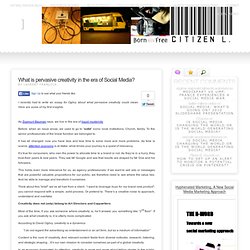

Virtual Reality. Neuroscience. How to correctly brief and provide a reco? A new Social Marketing Approach: Hyphenated Marketing. There's a big controversy these days in Social Media Marketing between the huge business opportunities and the fact that the more consumers are digitally empowered, the less they want to release their personal data and privacy to third parties. TNS Digital confirms this trend, demonstrating that not so many Social Networks users are open to brands.
In this attention economy, the competition has never been that strong. A competition that not only happens in a virtual world but truly in real life: local stores are progessively implementing Social Media tactics; mash-ups are now in-store (see H&M + Lanvin former collection). Marc Menesguen, Managing Director of Strategic Marketing for L’Oréal has recently declared for Cap Gemini that "The difference between the traditional model and the new one that is emerging, is a difference between positioning and movement.Today it’s not enough to think about brand positioning (...) the consumeris even more central to our strategy.
Connect: Authored by: Attention Economy. Bloggingheads: Information Obesity. BMW Guggenheim Lab. Part urban think tank, part community center and public gathering space, the BMW Guggenheim Lab aimed to raise awareness of important urban challenges and inspire an ongoing conversation in cities around the world.

From 2011 to 2013, this global project traveled to New York, Berlin, and Mumbai. Led by international, interdisciplinary teams of emerging talents in the areas of urbanism, architecture, art, design, science, technology, and sustainability, the Lab addressed issues of contemporary urban life through programs, projects, and public discourse. Launched in New York (August 3–October 16, 2011) with a focus on the theme of Confronting Comfort, the Lab traveled to Berlin (June 15–July 29, 2012), where the programming emphasized active citizen participation in shaping cities. It then opened at multiple sites in Mumbai (December 9, 2012–January 20, 2013), where projects and programs explored perceptions of privacy and public space. Visitors at the New York Lab. How the brain works while it is improvising. The 4 E's of Marketing (Ogilvy PR) Towards the Attention Economy: Will Attention Silos Ever Open Up?
We have written extensively at Read/WriteWeb about Attention and the Attention Economy.

As a concept attention makes sense to anyone who is online today. We know when we are paying attention and we know what we are paying attention to. The problem is that the information about our attention is not readily available to us afterwards. The premise of the Attention Economy is that people are in control of their attention information. This control lets them use the information to receive utility and services. The reality is that our attention information is scattered all over the web, bits of it lying in different silos. The Basics of Attention As we interact with information we reveal our attention. For example, a list of books that you purchased on Amazon can be used by a service that filters new book releases for you.
To learn more about modern recommendation engines, please read our previous post on the subject. Attention Silos Consider a different industry - banking. Ubiquitous Computing. Valery_conquete_ubiquite.pdf (Objet application/pdf) What is pervasive creativity in the era of Social Media? I recently had to write an essay for Ogilvy about what pervasive creativity could mean.

Here are some of my first insights. As Zygmunt Bauman says, we live in the era of liquid modernity. Before: when an issue arose, we used to go to “solid” icons: local institutions, Church, family. To the senior professionals of the linear function we belonged to. It has all changed: now you have less and less time to solve more and more problems. It’s true for consumers, who own the power to allocate time to a brand or not. This holds even more relevance for us, as agency professionals: if we want to sell ads or messages that are powerful valuable propositions for our public, we therefore need to see where the value lies.
Think about this “brief” we’ve all had from a client: “I want to leverage buzz for my brand new product”; you cannot respond with a simple, solid process. Creativity does not (only) belong to Art Directors and Copywriters.